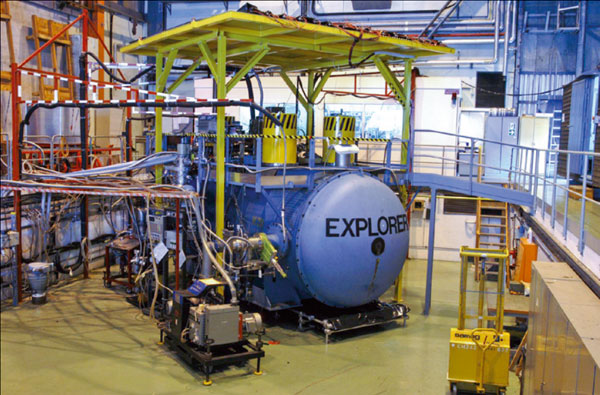
After 20 years of continuous operation, the EXPLORER gravitational-wave detector has come to the end of its long life as an experiment and left CERN. On 23 January it set off for a new existence at the European Gravitational Observatory (EGO) in Cascina, near Pisa, where it will become the main attraction in a new museum area. The detector’s main results span from the first modern upper limits on signals for gravitational waves bathing the Earth to the measurement of the dynamic gravitational field generated by an artificial source; from correlations with γ-ray and neutrino bursts to the acoustic detection of cosmic rays.
EXPLORER was the first gravitational-wave detector to reach the sensitivity and stability needed to perform long-term observations. Built and operated by INFN’s gravitational-wave groups at Rome and Frascati – first led by Edoardo Amaldi and Guido Pizzella and then by Eugenio Coccia – it was based on a cryogenic mechanical resonator, in the shape of a 3-m long aluminium cylindrical bar cooled to 2 K. It could be driven by a gravitational wave with spectral components at the bar’s resonant frequency, that is, about 1 kHz, and made use of superfluid helium to reduce thermal and vibrational noise and to allow the exploitation of high-sensitivity transducers and superconducting amplifiers. The experiment was able to detect changes as small as 10–19 m in the bar’s vibrational amplitude – a real achievement.
EXPLORER’s gravitational-wave sensitivity was limited to the strongest sources in the Galaxy. Now, the future of the field is represented by the network of large interferometers: the Laser Interferometer Gravitational-Wave Observatory with two interferometers in the US, Virgo at the EGO site in Italy, GEO in Germany and the Large-scale Cryogenic Gravitational wave Telescope in Japan. This network, which will comprise advanced versions of the instruments, should start detecting signals from many thousands of galaxies from the year 2015; typical sources of gravitational waves include supernovae, pulsars, and collisions of neutron stars and black holes. In the mean time, for the next three years, the Galaxy will be monitored by two modern cryogenic bars – Nautilus in INFN’s Frascati Laboratory and Auriga in INFN’s Legnaro Laboratory and by the GEO interferometer in Hanover.
• For more information, see http://gwic.ligo.org.





